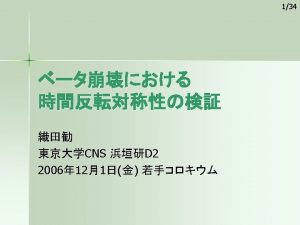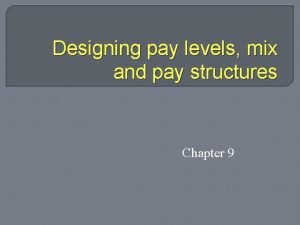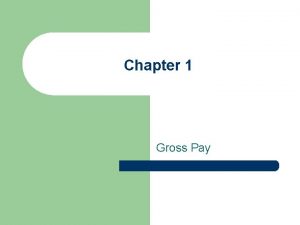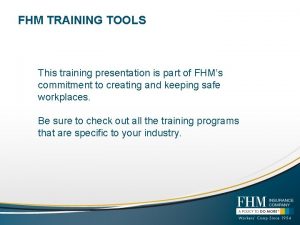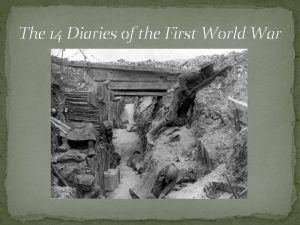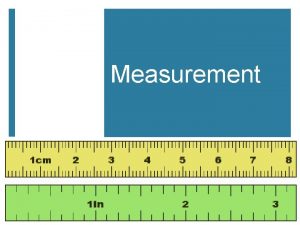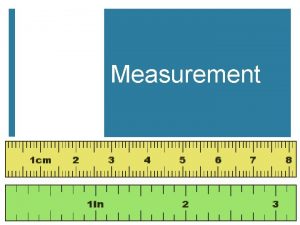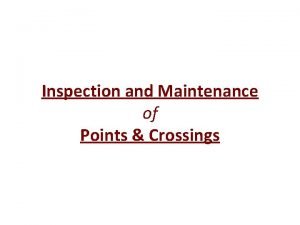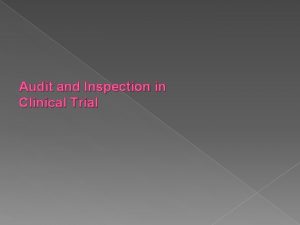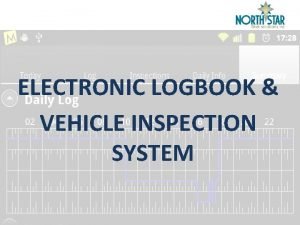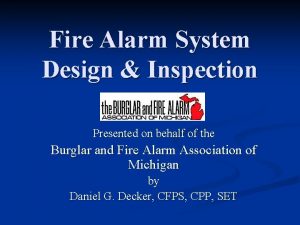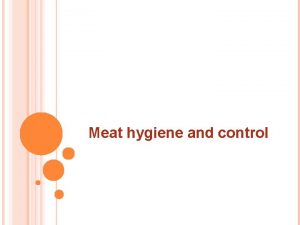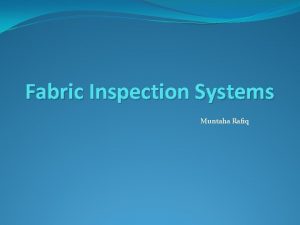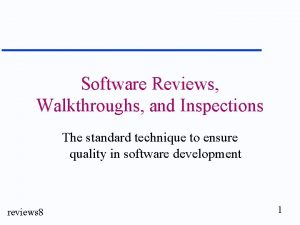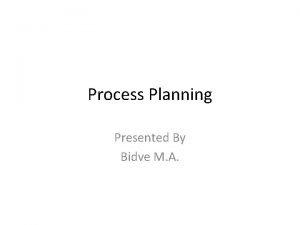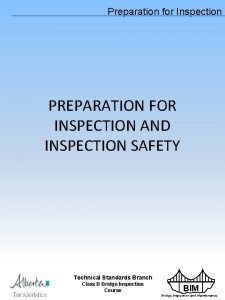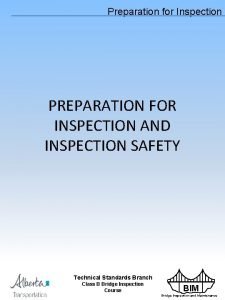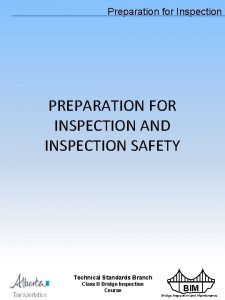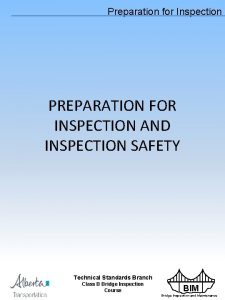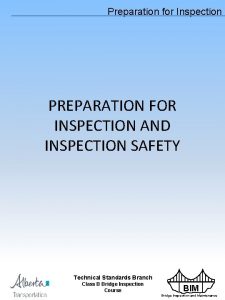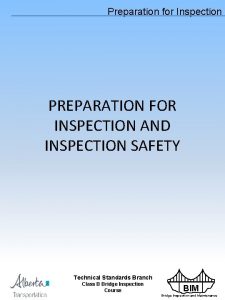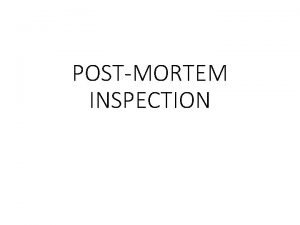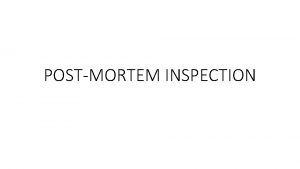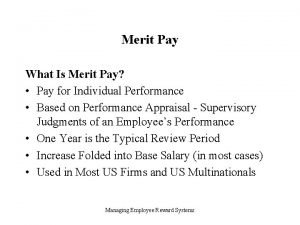INSPECTION PHILOSOPHY DAILY DIARIES AND PAY QUANTITY DIARIES





















































- Slides: 53

INSPECTION PHILOSOPHY, DAILY DIARIES AND PAY QUANTITY DIARIES City of Lee’s Summit

Today’s Agenda � Basic Inspection Philosophy � Contractor’s Responsibilities � Owner’s Responsibilities � Role of the “Engineer” � Scenarios � Project Documentation � Daily Diaries � Pay Quantity Diaries

Mike’s Philosophy… We are not the superintendents on the project. We don’t share the profit. We don’t share the risk.

Responsibility… The Contractor’s responsibilities are defined in the contract documents. EJCDC C-700, Article 6 – Contractor’s Responsibilities As with any responsibilities, these cannot be delegated away. Not to Sub-Contractors and certainly not to the Inspector

Contractor’s Responsibility… Just what does this article say? � 6. 01. Contractor shall supervise, inspect and direct the work… � 6. 01. Contractor shall be solely responsible for methods, means, techniques, sequences and procedures of construction. � 6. 02. Contractor shall provide competent, suitably qualified personnel to survey and lay out the work and perform construction as required by the contract documents.

Contractor’s Responsibility… � 6. 03. Contractor shall provide and assume full responsibility for all services, materials, equipment, labor, transportation, construction equipment and machinery, tools, appliances, fuel, power, light, heat, telephone, water, sanitary facilities, temporary facilities, and all other facilities and incidentals necessary for the performance, testing, start‑up, and completion of the Work. � 6. 06. Contractor shall be solely responsible for scheduling and coordinating the Work of Subcontractors, Suppliers, and other individuals or entities performing or furnishing any of the Work under a direct or indirect contract with Contractor.

Contractor’s Responsibility… � 6. 06. Contractor shall require all Subcontractors, Suppliers, and such other individuals or entities performing or furnishing any of the Work to communicate with Engineer through Contractor. � 6. 09. Contractor shall give all notices required by and shall comply with all Laws and Regulations applicable to the performance of the Work. � 6. 11. During the progress of the Work Contractor shall keep the Site and other areas free from accumulations of waste materials, rubbish, and other debris. Removal and disposal of such waste materials, rubbish, and other debris shall conform to applicable Laws and Regulations.

Contractor’s Responsibility… � 6. 13. Contractor shall be solely responsible for initiating, maintaining and supervising all safety precautions and programs in connection with the Work. � 6. 13. Contractor shall inform Owner and Engineer of the specific requirements of Contractor’s safety program with which Owner’s and Engineer’s employees and representatives must comply while at the Site.

Responsibility… The Owner’s responsibilities are also defined in the contract documents. EJCDC C-700, Article 8 – Owner's Responsibilities

Owner's Responsibility… Just what does this article say? � 8. 04. Owner shall make payments to Contractor when they are due as provided in Paragraphs 14. 02. C and 14. 07. C. � 8. 07. Owner is obligated to execute Change Orders as indicated in Paragraph 10. 03. � 8. 08. Owner’s responsibility with respect to certain inspections, tests, and approvals is set forth in Paragraph 13. 03. B.

Owner's Responsibility… � 8. 09. The Owner shall not supervise, direct, or have control or authority over, nor be responsible for, Contractor’s means, methods, techniques, sequences, or procedures of construction, or the safety precautions and programs incident thereto, or for any failure of Contractor to comply with Laws and Regulations applicable to the performance of the Work. � 8. 12. While at the Site, Owner’s employees and representatives shall comply with the specific applicable requirements of Contractor’s safety programs of which Owner has been informed pursuant to Paragraph 6. 13. D.

Role of the Engineer During Construction… The role of the Engineer is defined in the contract documents. EJCDC C-700, Article 9 – Engineer’s Status During Construction. Who is the Engineer? The term “Engineer” is defined in the project agreement, EJCDC C-520. This should refer to the City of Lee’s Summit Public Works Department.

Engineers Status During Construction (that’s you guys) … Just what does this article say? � 9. 02. Engineer will not be required to make exhaustive or continuous inspections on the Site to check the quality or quantity of the Work. � 9. 04. Engineer may authorize minor variations in the Work from the requirements of the Contract Documents which do not involve an adjustment in the Contract Price or the Contract Times and are compatible with the design concept of the completed Project as a functioning whole as indicated by the Contract Documents.

Engineers Status During Construction (that’s you guys) … � 9. 05. Engineer will have authority to reject Work which Engineer believes to be defective, or that Engineer believes will not produce a completed Project that conforms to the Contract Documents … � 9. 07. Engineer will determine the actual quantities and classifications of Unit Price Work performed by Contractor.

Engineers Status During Construction (that’s you guys) … � 9. 09. Engineer will not supervise, direct, control, or have authority over or be responsible for Contractor’s means, methods, techniques, sequences, or procedures of construction, or the safety precautions and programs incident thereto, or for any failure of Contractor to comply with Laws and Regulations applicable to the performance of the Work. � 9. 10. While at the Site, Engineer’s employees and representatives shall comply with the specific applicable requirements of Contractor’s safety programs of which Engineer has been informed pursuant to Paragraph 6. 13. D.

Final Thoughts… We are not the Project Superintendents, nor are we to act in that role. We do not share in the profits, nor should we share in the risks. Anytime you direct the contractor’s schedule, methods or means, you take on the risk. Watching vs. Inspecting… Watching is passive. Watching infers acquiescence and may result in sharing contractor’s risk - better to not be present at all than to simply watch and do nothing. Estoppel. Inspecting is Active. If you whiteness defective work, get involved. Document activities.

Scenario # 1 You are checking the reinforcing steel in the top slab of a box-culvert and discover that the location and spacing of the steel is wrong. The first load of concrete is currently being tested. What do you do?

Scenario # 1 It is the contractor’s responsibility to get the work right. Just-in-time inspection is okay.

Scenario # 2 One day after an ADA curb ramp was poured in December, high winds overnight have blow off the insulating blankets protecting the ramp. A thermometer records the surface temperature of the concrete at 38 degrees. You find the situation at 10 A. M. the next day. The contractor is not on the project. It is 18 degrees now. The forecast high is 25 degrees. What do you do?

Scenario # 2 As an inspector, it is your responsibility to notify the contractor if you become aware of a problem. It is the contractor’s responsibility to decide how to react to that problem.

Scenario # 3 You are the inspector over a concrete pavement pour. With just four loads of concrete left in the pour, an unexpected rain hits the project. The paving superintendent asks you if it is okay to place the last four loads of concrete. He informs you he has enough plastic to cover the pavement. How do you respond?

Scenario # 3 The contractor is responsible for completed work

Scenario # 4 A ready-mixed concrete truck driver is cleaning out his drum in a place that drains directly into a stream. When you confront him about it he becomes belligerent. What do you do?

Scenario # 4 As an inspector you have the authority to insist upon contract compliance. It is the contractor’s responsibility to deal with suppliers.

Scenario # 5 A by-pass is being torn up under traffic. You tell the contractor to make repairs. The contractor refuses, saying the by-pass is under-designed. What do you do?

Scenario # 5 It may be that the bypass is under-designed. But, the present issue is that it must be maintained. Design can be investigated later. In the meantime, keep records to help resolve any potential claim.

Scenario # 6 You are the inspector for a curb replacement project. You check the weeks forecast and it says 70% chance of heavy rain for the next five days. You drive out to the site and observe the tear out crew removing curb. What do you do.

Scenario # 6 Remember, the Contractor is solely responsible for methods, means, techniques, sequences and procedures of construction. If we take on this role, we are accepting some risk.

Engineer/Contractor Relations These scenarios are examples of crisis-management. Strive to head off problems before they reach that stage. § Remember, we are not here to break contractor’s. We are here to ensure compliance with the contract documents. It’s okay if the contractor makes a profit. In fact, it’s a good thing. § Always relate to the contractor as part of the solution, not part of the problem § But if there are issues, DOCUMENT… §

Non-uniform enforcement can cause problems � If an inspector yields on a specification requirement without good reason, a new “bench mark” is set and the contractor and other contractors feel entitled to that yielding from that point on. � Many of us work with the same contractor’s. We must always speak with a unified voice. � There are times exceptions must be made. We must be able to defend our actions to other contractors. Including the second low bidder.

Break Time

Daily Diaries & Pay Quantity Diaries How to maintain a Daily Diary and Pay Quantity Diaries for CIP projects This applies to all CIP projects regardless of funding. Federal, State or 100% Local Funds Aside from Labor documentation, Development Inspectors should record the same information in their Daily Diaries. This information may become critical for supporting future warranty claims.

Why are Diaries Necessary and Important Documentation of the contractor and his activities is required for ALL Capital Improvement Projects. Why… � Official record of daily events on project � � � Accurate record of required repairs or modifications Assures QC/QA is taking place Accurate record of work completed Source documentation for payments to contractor Clearly Communicates Inspectors Actions Accurate records keep us out of court

Good Diary Etiquette Five C’s of Good Report Writing: • Clear – Being clear refers to both handwriting and meaning. Being clear in meaning is essential. What ever is written has to be clear even to people not involved with the project. • Concise – Being concise means using the minimum number of words to get the maximum amount of meaning. The rule is, write enough to be clear, but not any more than is necessary. Record the facts and keep opinions out of your diary. • Correct – Being correct means having your facts straight and using the right forms. Using the wrong form, or making errors, gives the appearance of sloppiness and can cause big problems in arbitrations or litigation proceedings.

Good Diary Etiquette Five C’s of Good Report Writing: • Complete – Being complete means including everything necessary to be clear. To be complete, the entry should contain four criteria: Activity–Testing–Results-Action Taken, as well as referencing other types of available project documentation. • Concurrent – Contract documentation should be completed concurrent with the construction activity. Extensive facts, figures and conversations are hard to remember, write them down as soon as possible, taking abbreviated notes.

Facts Only !! No Opinions The diary records the inspector’s project specific observations and measurements, which provides valuable project information. • Be professional – No Personal comments • Instill Credibility into Project records The documentation also provides historical information on how the work was constructed. • Daily information recorded, not • Evidence in Claim Resolution week to week or month to month

Diary Tips… Ø Ø Carry a small note pad in your pocket at all times. As things happen, jot down a short note. This will keep you from forgetting what happened during the day. Update the Daily Diary DAILY! Pick a time at the end of the day and try to stick to a routine. If the end of the day wont work, update the Diary throughout the day. Do NOT put it off! While you may, on occasion, have to put it off until the next day, this should be the exception and not the rule. This is not an option. It is a requirement for any project receiving Federal Funds. An inadequate Diary is cause for the FHWA to withhold funds.

Diary Tips… Ø Ø While Photographs can provide additional information to support the written diaries, photographs are not an accepted alternative to written Diaries. We currently have no means for an electronic diary. Keeping notes in a Word document on a laptop is not an acceptable form. More on this later.

Two Types of Project Diaries (required for every project) • • Daily Dairy – (Inspector’s Diary) Includes entries such as: • Date & Weather • Document every rain event • Instructions/conversation w/ Contractor, property owners, project managers, etc. • • • Pay Quantity Diary All contract bid items must be listed All bid items shall include: • Item Description • Plan Quantity • Price • Quantity Placed (Today & To Date) • Office or Field Visitors • Location (Station, Lt. or Rt. ) • Equipment & Manpower Present • Inspector’s Signature/Initial • Wage Information. DBE & CUF if required • Remarks • Sketches or Drawings if Needed • Material Delivery & Certifications • Material Rejection w/ explanation • Testing & Results • The inspector shall verify all pay items incorporated into the project

Daily Diary The Daily/Inspector’s diary should represent a summary of the days construction activities. Ø In addition to recording inspection observations and measurements, inspectors should summarize delays, breakdowns, idle time, changes in production rates, work accomplished and other important events that effect or objectively explain the contractor’s progress. Ø It is very important for the inspector to record when a subcontractor begins work on the project and when that subcontractor’s work was complete. These entries shall correspond to payroll records and DBE/CUF reports when required. Ø

Daily Diary Material Delivery should be noted in the diary as well as the accompanying certifications for the material and their coatings. Note if incidental materials were used and if they were from an approved source. ( Epoxy paint, Curing Compound, Linseed Oil, etc. ) Ø Testing and results should be documented every time a test is performed. If test results are not documented, they never occurred. Ø When required by the contract, document what DBE’s were present on the project and what commercially useful function (CUF) were they performing. What was accomplished for the day. Were CUF interviews performed at least once per DBE vendor? Ø

Daily Diary Examples

Daily Diary Examples

Pay Item Diary Ø Ø Pay item information should include location, quantity, correct unit of measurement, line item number, item description, and remarks. Pay quantities are required to be measured and documented for contract payment and tracking purposes. They should be measured and entered daily. List if item was supplied or installed by DBE and how much man power and time it took. Good documentation of pay quantities is needed to avoid underpaying, overpaying, or double-paying the contractor for completed work.

Pay Item Diary Examples

Pay Item Diary Examples

Pay Item Diary Examples

Pay Item Diary Examples

Pay Item Diary (Set-Up) Examples

Summary All Diary entries should be able to answer the following: ü Who ü What ü Where ü When

Summary Ø Ø Ø Be neat and legible Record data in a clear and consistent manner Bound field book is best. § Computer Dairies are allowed if securely backed up. Dairies can not be changed once saved. Ø Ø Ø Part of project’s permanent record Never erase or white-out, if you must revise your documentation, line through bad documentation, date and initial If in doubt…write it down!

Additional References For more information, see Mo. DOT’s LPA Construction Guidance in EPG 136. 11.

Questions
 Difference between vector and scalar quantity
Difference between vector and scalar quantity Scalar quantity and vector quantity
Scalar quantity and vector quantity Distance is scalar
Distance is scalar Polar and axial vector pdf
Polar and axial vector pdf Quantity y varies inversely as quantity x.
Quantity y varies inversely as quantity x. Designing a pay structure
Designing a pay structure Section 1-1 hourly pay answers
Section 1-1 hourly pay answers Overhead crane inspection checklist doc
Overhead crane inspection checklist doc Daily crane inspection checklist doc
Daily crane inspection checklist doc Paycheck
Paycheck Merit pay vs incentive pay
Merit pay vs incentive pay Arte 14 - diaries of world war i
Arte 14 - diaries of world war i Vampire diaries caleb
Vampire diaries caleb Princess diaries reporter
Princess diaries reporter Che guevara quotes motorcycle diaries
Che guevara quotes motorcycle diaries Shoot diaries meaning
Shoot diaries meaning Expressions of quantity
Expressions of quantity What is a single price monopoly
What is a single price monopoly How to calculate real gdp from price and quantity
How to calculate real gdp from price and quantity Difference between supply and quantity supplied
Difference between supply and quantity supplied Change in supply and change in quantity supplied
Change in supply and change in quantity supplied Taiwan inflation rate
Taiwan inflation rate A vector quantity has ______ and direction.
A vector quantity has ______ and direction. Difference between quality and quantity
Difference between quality and quantity Scalar and vector quantity difference
Scalar and vector quantity difference What are the elements of categorical proposition
What are the elements of categorical proposition The relationship between strength and total quantity is
The relationship between strength and total quantity is A quantity that has both a number and a unit
A quantity that has both a number and a unit A quantity that has both a number and a unit
A quantity that has both a number and a unit The relationship between strength and total quantity is
The relationship between strength and total quantity is The relationship between strength and total quantity
The relationship between strength and total quantity Number and quantity praxis problems
Number and quantity praxis problems What is security survey
What is security survey Difference between inspection and audit
Difference between inspection and audit Da form 5988e
Da form 5988e For cause audit
For cause audit Inspection and self evaluation framework
Inspection and self evaluation framework Vertical wear on tongue rail
Vertical wear on tongue rail Audits and inspections of clinical trials
Audits and inspections of clinical trials Inspection committee in procurement
Inspection committee in procurement Regulation and inspection of social care wales
Regulation and inspection of social care wales Incidental additives examples
Incidental additives examples E.l.v.i.s. inspection form
E.l.v.i.s. inspection form Lingula auscultation
Lingula auscultation Design and inspection of fire alarm system
Design and inspection of fire alarm system Kuok kim macau
Kuok kim macau Textile raw
Textile raw Meat hygiene
Meat hygiene Lifting tackles list
Lifting tackles list Fabric inspection 6 point system
Fabric inspection 6 point system Inspection and palpation
Inspection and palpation Peer review walkthrough and inspection in software testing
Peer review walkthrough and inspection in software testing Difference between inspection and quality control
Difference between inspection and quality control Poultry meat hygiene and inspection
Poultry meat hygiene and inspection



